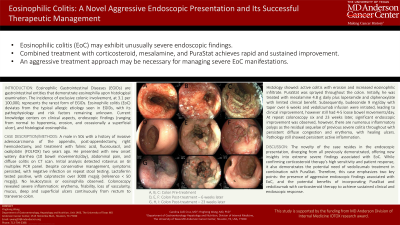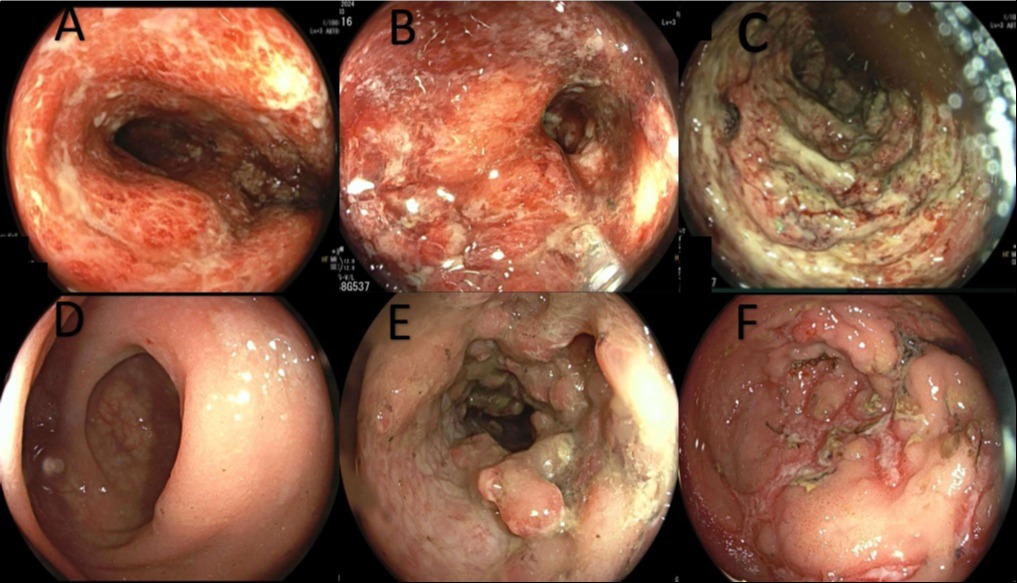Tuesday Poster Session
Category: Colon
P3759 - Eosinophilic Colitis: A Novel Aggressive Endoscopic Presentation and Its Successful Therapeutic Management
Tuesday, October 29, 2024
10:30 AM - 4:00 PM ET
Location: Exhibit Hall E

Has Audio
- CC
Carolina Colli Cruz, MD
MD Anderson Cancer Center
Houston, TX
Presenting Author(s)
Carolina Colli Cruz, MD1, Yinghong Wang, MD, PhD2
1MD Anderson Cancer Center, Houston, TX; 2University of Texas MD Anderson Cancer Center, Houston, TX
Introduction: Eosinophilic Gastrointestinal Diseases (EGIDs) are gastrointestinal entities that demonstrate eosinophilia upon histological examination. The incidence of exclusive colonic involvement, at 3.1 per 100,000, represents the rarest form of EGIDs. Eosinophilic colitis (EoC) deviates from the typical allergic etiology seen in EGIDs, with its pathophysiology and risk factors remaining unknown. Current knowledge centers on clinical aspects, endoscopic findings (ranging from normal to hyperemia, erosion, and occasionally a superficial ulcer), and histological eosinophilia.
Case Description/Methods: A 57-year-old male with a history of invasive adenocarcinoma of the appendix, post-appendectomy, right hemicolectomy, and treatment with folinic acid, fluorouracil, and oxaliplatin (FOLFOX) two years ago. He presented with new onset watery diarrhea (10 bowel movements/day), abdominal pain, and diffuse colitis on CT scan. Initial analysis detected rotavirus A infection on gastrointestinal multiplex PCR panel. Despite conservative management, symptoms persisted, with negative infection on repeat stool testing. Lactoferrin tested positive, with calprotectin over 3000 mcg/g (reference < 50 mcg/g). No leukocytosis or eosinophilia observed. Colonoscopy revealed severe inflammation: erythema, friability, loss of vascularity, mucus, deep and superficial ulcers continuously from rectum to transverse colon. Histology showed: active colitis with erosion and increased eosinophilic infiltrate. PuraStat was sprayed throughout the colon. Initially, he was treated with mesalamine 4.8 g daily plus loperamide and diphenoxylate with limited clinical benefit. Subsequently, budesonide 9 mg/day was initiated, with taper over 6 weeks, leading to clinical resolution. At repeat colonoscopy six weeks later , significant endoscopic improvement was observed. Decision made to continue mesalamine treatment for maintenance.
Discussion: The novelty of the case resides in the endoscopic presentation, diverging from all previously demonstrated, offering new insights into severe findings associated with EoC. While confirming corticosteroid therapy’s high sensitivity and patient response, it also demonstrates the potential benefits of combining mesalamine and PureStat. Therefore, this case emphasizes two key points: the presence of aggressive endoscopic findings associated with EoC, and the potential benefits of incorporating PureStat and mesalamine with corticosteroid therapy to achieve rapid and sustained clinical and endoscopic response.

Disclosures:
Carolina Colli Cruz, MD1, Yinghong Wang, MD, PhD2. P3759 - Eosinophilic Colitis: A Novel Aggressive Endoscopic Presentation and Its Successful Therapeutic Management, ACG 2024 Annual Scientific Meeting Abstracts. Philadelphia, PA: American College of Gastroenterology.
1MD Anderson Cancer Center, Houston, TX; 2University of Texas MD Anderson Cancer Center, Houston, TX
Introduction: Eosinophilic Gastrointestinal Diseases (EGIDs) are gastrointestinal entities that demonstrate eosinophilia upon histological examination. The incidence of exclusive colonic involvement, at 3.1 per 100,000, represents the rarest form of EGIDs. Eosinophilic colitis (EoC) deviates from the typical allergic etiology seen in EGIDs, with its pathophysiology and risk factors remaining unknown. Current knowledge centers on clinical aspects, endoscopic findings (ranging from normal to hyperemia, erosion, and occasionally a superficial ulcer), and histological eosinophilia.
Case Description/Methods: A 57-year-old male with a history of invasive adenocarcinoma of the appendix, post-appendectomy, right hemicolectomy, and treatment with folinic acid, fluorouracil, and oxaliplatin (FOLFOX) two years ago. He presented with new onset watery diarrhea (10 bowel movements/day), abdominal pain, and diffuse colitis on CT scan. Initial analysis detected rotavirus A infection on gastrointestinal multiplex PCR panel. Despite conservative management, symptoms persisted, with negative infection on repeat stool testing. Lactoferrin tested positive, with calprotectin over 3000 mcg/g (reference < 50 mcg/g). No leukocytosis or eosinophilia observed. Colonoscopy revealed severe inflammation: erythema, friability, loss of vascularity, mucus, deep and superficial ulcers continuously from rectum to transverse colon. Histology showed: active colitis with erosion and increased eosinophilic infiltrate. PuraStat was sprayed throughout the colon. Initially, he was treated with mesalamine 4.8 g daily plus loperamide and diphenoxylate with limited clinical benefit. Subsequently, budesonide 9 mg/day was initiated, with taper over 6 weeks, leading to clinical resolution. At repeat colonoscopy six weeks later , significant endoscopic improvement was observed. Decision made to continue mesalamine treatment for maintenance.
Discussion: The novelty of the case resides in the endoscopic presentation, diverging from all previously demonstrated, offering new insights into severe findings associated with EoC. While confirming corticosteroid therapy’s high sensitivity and patient response, it also demonstrates the potential benefits of combining mesalamine and PureStat. Therefore, this case emphasizes two key points: the presence of aggressive endoscopic findings associated with EoC, and the potential benefits of incorporating PureStat and mesalamine with corticosteroid therapy to achieve rapid and sustained clinical and endoscopic response.

Figure: Title: Eosinophilic Colitis.
A, B, C: Colon Pre-treatment
D, E, F: Colon Post-treatment (6 weeks later)
A, B, C: Colon Pre-treatment
D, E, F: Colon Post-treatment (6 weeks later)
Disclosures:
Carolina Colli Cruz indicated no relevant financial relationships.
Yinghong Wang: AzurRx – Consultant. Ilyapharma – Consultant. IOTA – Consultant. Sorriso – Consultant. Tillotts – Consultant.
Carolina Colli Cruz, MD1, Yinghong Wang, MD, PhD2. P3759 - Eosinophilic Colitis: A Novel Aggressive Endoscopic Presentation and Its Successful Therapeutic Management, ACG 2024 Annual Scientific Meeting Abstracts. Philadelphia, PA: American College of Gastroenterology.
